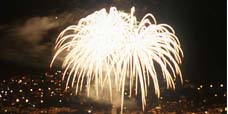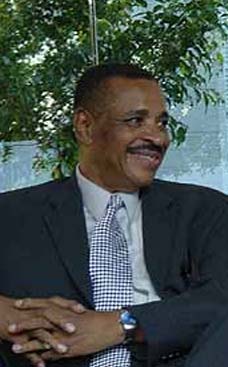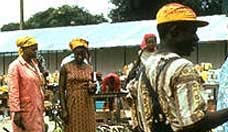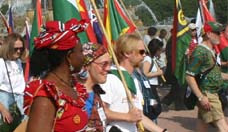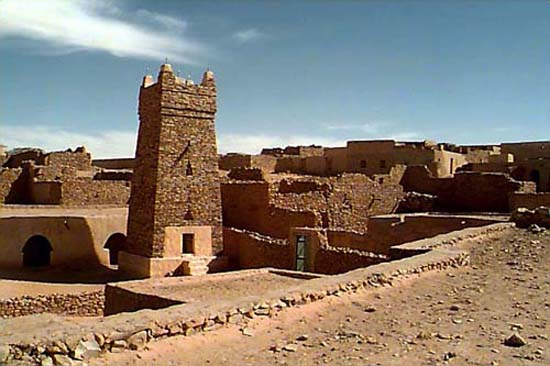
"Nearly every building, whether it is a shack, latrine, house, boutique, or school, is constructed with bricks akin to cinder blocks with healthy layers of plaster on all sides. The blocks are called dutch bricks, and they are fashioned by brick-makers using a mixture predominantly composed of sand, of which there is plenty, naturally. These are then covered with plaster and sometimes painted – I was in a village last weekend and saw a beautiful polygonal representation of a bull. But, unfortunately, such artistic touches are rare and most end up looking like rigid extensions of the sand below. Windows and doors are afterthoughts, and many windows are literally punched out of a wall."
Peace Corps Volunteer Aaron in Mauritania
Architectural digestion
July 30th, 2005
I am nothing if not a slave to my faithful readers, so let me start off by soliciting requests from you. I know I have done a pretty piecemeal job so far of painting a picture of life here, so if there are any glaring omissions, please let me know.
That being said, someone asked about the architecture here, and I’m happy to write about it. Don’t get your hopes up, though – the buildings here are an architect’s worst nightmare, aesthetically and functionally.
Nearly every building, whether it is a shack, latrine, house, boutique, or school, is constructed with bricks akin to cinder blocks with healthy layers of plaster on all sides. The blocks are called dutch bricks, and they are fashioned by brick-makers using a mixture predominantly composed of sand, of which there is plenty, naturally. These are then covered with plaster and sometimes painted – I was in a village last weekend and saw a beautiful polygonal representation of a bull. But, unfortunately, such artistic touches are rare and most end up looking like rigid extensions of the sand below. Windows and doors are afterthoughts, and many windows are literally punched out of a wall.
Most families, both in the city and in the villages, live on properties called compounds – with only three million people in this country, space is plentiful. Compounds in the city are surrounded by walls (also constructed of dutch bricks) that reach anywhere from 3 to 7 feet high. Structures inside the compound vary, so I’ll describe mine, but keep in mind that my family is relatively wealthy. We have a house – a bona fide house – that has three bedrooms, a salon, and two closets. Notice I did not say a kitchen, a basement, a second floor, or a bathroom. As per Peace Corps policy, I have my own room with a locking door. The house has a hallway/entryway that also serves as a place for our refrigerator, a dining room at midday (nights we eat outside), and a kitchen when the need arises (more about this in a bit).
The house has a stairway on the outside that leads to the rooftop terrace, which is my favorite place to sleep because it’s that much closer to the wide-open night sky. There is a little closet underneath the stairway (think Sixth Sense) and when the weather is good, the cooking is done here. Across the yard (sand pit) lies a “hangar” which is an interesting concrete tent-like structure which I surmise is a relic from the very-recently-abandoned nomadic traditions. Not every compound has a hangar, but most do, and they can vary from bamboo beams (don’t ask me where they come from) to sticks found in the street covered with a tarp. The tarp is very often white vinyl on the exterior, to protect from the elements, but beautiful fabrics are sewn onto the underside, the closest thing I’ve seen to quilting here. Families will sleep and generally hang out under here.
Immediately next to the hangar is our latrine/shower, which lies closest to the street and furthest from the house (thank goodness). This bad boy is a shack divided into two rooms, one of which you poop in and the other of which you take a shower. At first I thought it extremely strange and somewhat unhealthy to have these so close, but then I remembered that in the United States we put them in the same room.
One of the most fascinating aspects of life here, which I also attribute to the ex-nomadic culture, is the flexible and multi-functional uses of space and objects. As I like to put it, anything that is not nailed down can and will be used everywhere. A few examples: I previously mentioned that we have a TV. It’s small, probably 20” or 19”, and as such, it gets moved everywhere, its power and antenna cords in tow – in the salon, hallway, or hangar. Also, cooking is done everywhere with the help of a burner affixed to a tiny Shell gas can and a charcoal stove, the only heating sources available. And the family eats and sleeps just about anywhere, nearly always at ground level.
All of this means that an architect’s job would be difficult here, because life happens in spite of the buildings, not because of them. Or, perhaps, the job would easily be done since simple concrete boxes will more often than not suffice.






